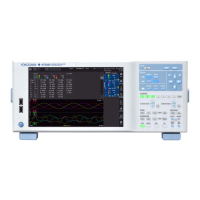8-3
IM WT5000-01EN
• Delta computation
Δ
U1( ): DELTAU1( )
Δ
I( ): DELTAI( )
Δ
P1( ): DELTAP1( )
Δ
U2( ): DELTAU2( )
−−−
Δ
P2( ): DELTAP2( )
Δ
U3( ): DELTAU3( )
−−−
Δ
P3( ): DELTAP3( )
Δ
U
Σ
( ): DELTAUSIG( )
−−−
Δ
P
Σ
( ): DELTAPSIG( )
Δ
U1rms( ): DELTAU1RMS( )
Δ
U1mean( ): DELTAU1MN( )
Δ
U1rmean( ): DELTAU1RMN( )
Δ
U2rms( ): DELTAU2RMS( )
Δ
U2mean( ): DELTAU2MN( )
Δ
U2rmean( ): DELTAU2RMN( )
Δ
U3rms( ): DELTAU3RMS( )
Δ
U3mean( ): DELTAU3MN( )
Δ
U3rmean( ): DELTAU3RMN( )
Δ
U
Σ
rms( ): DELTAUSIGRMS( )
Δ
U
Σ
mean( ): DELTAUSIGMN( )
Δ
U
Σ
rmean( ): DELTAUSIGRMN( )
Δ
U1dc( ): DELTAU1DC( )
Δ
U1ac( ): DELTAU1AC( )
Δ
Irms( ): DELTAIRMS( )
Δ
U2dc( ): DELTAU2DC( )
Δ
U2ac( ): DELTAU2AC( )
Δ
Imean( ): DELTAIMN( )
Δ
U3dc( ): DELTAU3DC( )
Δ
U3ac( ): DELTAU3AC( )
Δ
Irmean( ): DELTAIRMN( )
Δ
U
Σ
dc( ): DELTAUSIGDC( )
Δ
U
Σ
ac( ): DELTAUSIGAC( )
Δ
Idc( ): DELTAIDC( )
−−− −−−
Δ
Iac( ): DELTAIAC( )
• Motor evaluation (option)
Speed: SPEED( ) Torque: TORQUE( ) Pm: PM( )
Slip: SLIP( ) SyncSp: SYNC( ) −−−
EaM1U: EAM1U( ) EaM1I: EAM1I( ) −−−
EaM3U: EAM3U( ) EaM3I: EAM3I( ) −−−
• Auxiliary input (option)
Aux1:AUX1( ) Aux2:AUX2( ) Aux3:AUX3( )
Aux4:AUX4( ) Aux5:AUX5( ) Aux6:AUX6( )
Aux7:AUX7( ) Aux8:AUX8( ) −−−
• Measurement range
RngU:RNGU( ) RngI:RNGI( )
RngSpd:RNGSPD( )
1
RngTrq:RNGTRQ( )
*
RngAux: RNGAUX1( ) to RNGAUX8( )*
* Models with the motor evaluation 1 or 2 option
Setting the Operand Parameters
The parameters that you need to enter depend on whether the function is followed by “( , )” or “( )”.
• ( , ) Notation
Specify the element to the left of the comma, and specify the harmonic order to the right of the comma. For
example: (E1,OR2).
• Symbols representing elements
E1 to E7: Elements 1 to 7
SA to SC: Wiring units ΣA to ΣC
• Symbols representing harmonic orders (Order)
ORT: Total value
OR0: dc
OR1: Fundamental wave
OR2 to OR500: Harmonic orders 2 to 500
• Setting Parameters for Functions Followed by “( )”
• For measurement functions other than Speed, Torque, Pm, Slip, or SyncSp, depending on the function,
set the symbol representing the element, or you may not need to set it. For example, set it as (E1). For
information about the symbols that can be used for the parameters of each operand, see appendix 6 in the
Getting Started Guide, IM WT5000−03EN.
• For the Speed, Torque, Pm, Slip, and SyncSp measurement functions, set M1 to M4, which are symbols
representing the motor numbers. For example, set it as (M1).
8 Computation Function

